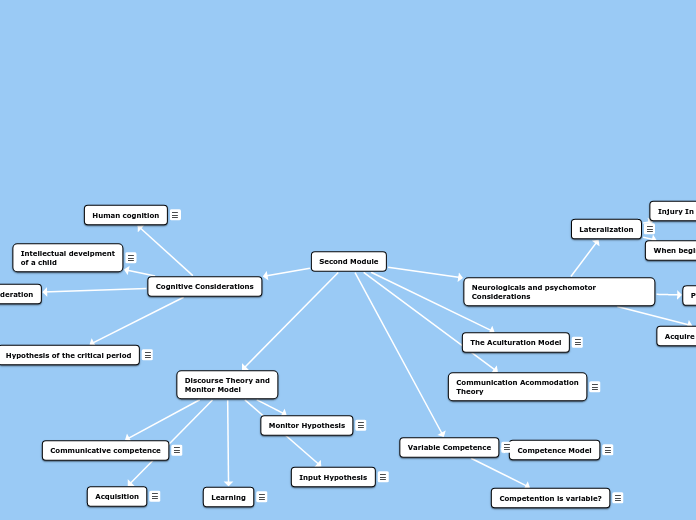Second Module
Cognitive Considerations
Human cognition
Human cognition develops rapidly throughout the first 16 years of life and less rapidly after adulthood. Some of these changes are critical, others are more gradual and difficult to detect.
Intellectual develpment
of a child
The sensorimotor stage from ages 0 to 2.The preoperational stage from ages 2 to 7.Concrete operational stage from ages 7 to 11.Formal operational stage from ages 11 to 16.
Liguistic consideration
Coordinate bilinguals
People learn two languages in different contexts (home and school)
Compound bilinguals
People learn two languages in the same environment, and the same time the culture of that place (Way to speak)
Bilingualism
Children learning two languages simultaneously use the same acquisition strategies.
Hypothesis of the critical period
A critical stage for a consideration of the effects of age on second language acquisition appears to occur, in Piaget’s outline, at puberty (age 11 in his model). It is here that a person becomes capable of abstraction, of formal thinking which transcends concrete experience and direct perception.
Discourse Theory and
Monitor Model
Communicative competence
Communicative competence is the ability to achieve communicative goals in a socially appropriate manner. it includes the ability to select and apply skills that are appropriate and effective in the respective context. It includes verbal and non-verbal behaviour.
Monitor Hypothesis
The monitor hypothesis asserts that a learner's learned system acts as a monitor to what they are producing. In other words, while only the acquired system is able to produce spontaneous speech, the learned system is used to check what is being spoken.
Input Hypothesis
This states that learners progress in their knowledge of the language when they comprehend language input that is slightly more advanced than their current level.
Acquisition
Acquisition. • Subconscious process.• Meaningful interaction.• Communicative act.• Main concepts.
Learning
Learning. • Conscious process. • Formal instruction. • Grammar. • Main concepts
Variable Competence
This model suggests the learning occurs through the use between subconscious and automatic processes and conscious and analytical processes, the learner can active one or other, according to the type of discourse that the learner uses.
Competention is variable?
Tarone (1983, 1985) argues that interlanguage speakers shift the style in which they speak along a continuum from a careful style to the vernacular. According to this point of view, variability is linked to style- shifting, which is in turn linked to the amount of attention which is paid to speech in a given speech situation. Researchers like Tarone and Ellis who are more interested in performance than competence have assumed that any underlying "competence" must reflect the way in which performance varies.
Competence Model
The process of language.Is more pragmatic than we think, people have far more understanding of the language than what is expressed in discourse.The product of language.Is the plan and unplanned discourse discussed previously, where the user chooses to speak out of a source of general knowledge to provide automatic information or to speak meticulously planning ahead what is to be said.
Neurologicals and psychomotor Considerations
Lateralization
There is evidence in neurological research that as the human brain matures certain functions are assigned - or "lateralized".
Injury In the left hemisphere
In the case of a children up to the age of puberty, suffer a injury to the left hemisphere, this is able to relocalize linguistic functions to the right hemisphere, to “re-learn”
When begin the process?
The process begins around the age of 2 and is completed around puberty.
Lenguage Acquisition
The child is able to neurologically assigning functions little by little to one side of the brain or the other, in the case the acquisition of a second language too
Acquire a native speaker lenguage
At birth, the speech muscles are developed only to the extent that the larynx control sustained cries. These speech muscles gradually develop, and control of some complex sounds in certain languages (in English the r and l typical).
Plascity
The plasticity of the brain makes capable to a children to acquire not only their first language but also a second language.
The Aculturation Model
It can be the process of cultural change that occurs when individuals from different cultural backgrounds come into prolonged, continuous, first-hand contact with each other
Communication Acommodation
Theory
People adopt the slang their friends use to fit in. People talk differently using different words and gestures accordingly to the different group of people like old people, children, women, men, teens, rich, poor, powerful, weak, etc.
